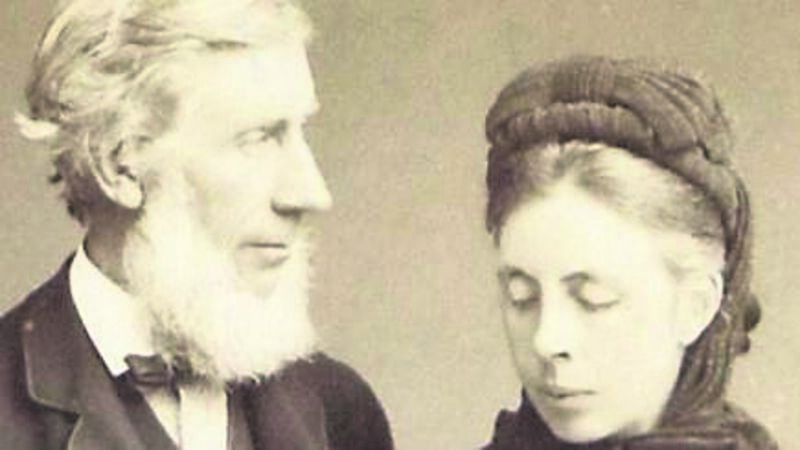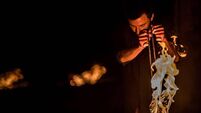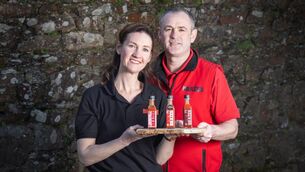Tyndall’s plan to save firefighters

John and Louise Tyndall.
In the midst of much smoke, free breathing may be obtained by applying to the face a wet silk handkerchief, a wet worsted stocking, a wet sponge, or any wet flannel substance folded.
From Rules and Instructions of the Cork Fire Brigade, 1882
ALMOST from the time fire brigades were first formed, the problem of breathing in toxic atmospheres had exercised firemen’s minds.
Some old firefighters had a tremendous reputation as legendary ‘smoke eaters’; cachets acquired from sheer guts, the ability to take frightful punishment (which they often described as a ‘shellacking’) and a foolhardy inclination to take unwarranted risks.
In olden days, a face full of whiskers was an essential requirement of every fireman, and one of his first orders at arriving at an outbreak was: ‘Wet your beard, take it between your teeth, and in you go through the smoke’!

However that may be, it can be truthfully said that two prominent Irishmen were to the fore in the development of an early ‘breathing apparatus’ for the fire service.
One day in 1870 — 150 years ago this year — a hansom cab was carrying a fare through London when it was stopped by a policeman who, due to a bad fire in a building further up the street, would not allow it to continue any further.
The customer decided to dismount and finish his journey on foot. Pushing his way through the crowds of spectators, he decided to pause and watch the fire brigade at work. From the house poured the thickest, blackest smoke that he had ever seen. Presently, a brass-helmeted fireman staggered out the front door, carrying the limp body of a girl in his arms.
Unlike the highly sentimental, often unreal depiction of firefighters beloved of high Victorian academic painters — in which the subject, in pristine uniform and without as much as a fleck of soot on his rugged face, emerges from the inferno, unscathed and in heroic stance — this was something altogether different. The little girl, sadly, was dead, and, to the spectator, the fireman looked already half-dead.
With tears and mucus streaming from his eyes and nostrils, his uniform soaked and filthy from the fire detritus, all he could do, having handed over the child to some colleagues, was to collapse, exhausted, on the pavement and suck in great lungful’s of reviving fresh air.
The spectator was appalled at what he had observed and quietly resolved to do something about it.
******
The concerned observer was none other than Professor John Tyndall, one of the most influential and inspirational physicists in the latter half of the 19th century and after whom the Cork-based (and world-famous) Tyndall National Institute is named — a leading European research centre in integrated Information and Communications Technology (ICT).
Energetic, charismatic, ambitious, pro-Unionist, anti-Church, and contrary, Tyndall is regarded today as one of the giants of Victorian science and a pioneer of analytical instrumentation. He published 17 books which brought state-of-the-art experimental physics to a wider audience. From 1853 to 1887, he was Professor of Physics at the Royal Institution of Great Britain in London.
John Tyndall was born at Leighlinbridge, Co. Carlow, on August 2, 1820. His father, a shoemaker, joined the police and rose to the rank of Sergeant. His parents set much store in a sound education, and, although Church of Ireland, insisted on their children walking the four miles every morning to the small Roman Catholic country school where Master Conwill had a great reputation, teaching the likes of co-ordinate geometry to his young charges.

At an early age, Tyndall established himself as Conwill’s brightest pupil, able to visualize geometry without diagrams. Unable for financial reasons to attend university, on leaving school he joined the Ordnance Survey Office in Carlow, later serving at their Youghal office. In 1842, he was transferred to Preston, England, but after he, and his co-workers, complained about conditions they were sacked.
Work as a Surveyor followed, then as a teacher in Hampshire, all the time continuing his education through reading and attendances at lectures. In 1848, Tyndall went to Germany to study for a PhD in mathematics, physics and chemistry. He was now on the cusp of a career that, in spite of uncertain beginnings, would establish him as one of the giants of science.
******
Upset at what he had seen at the fire in London, Tyndall approached the Chief Officer of the Metropolitan Fire Brigade, Captain Eyre Massey Shaw, with a view to collaborating on the development of a respirator for firemen.
Cobh-born Shaw, scion of the Shaws of Monkstown Castle, Co. Cork, was, in 1871 when he met Tyndall, ten years at the helm of London’s fire service. A graduate of Trinity College, Dublin, he had served as a Captain in the North Cork Militia and as Chief Constable and Chief Fire Officer (a dual post) in Belfast.
In 1861, following the death at a fire of James Braidwood, he was appointed Superintendent of the London Fire Engine Establishment (a brigade funded by the insurance companies).
With the institution by Act of Parliament of the Metropolitan Fire Brigade in 1866, Shaw became its first ‘Chief Officer’. Like Tyndall, he, too, would become a legend in his lifetime.
Tyndall later recalled: “I proposed to Captain Shaw to bring the matter (of a respirator) to a test at his workshops in the city. He was good enough to accept my proposal, and thither I went.
“The smoke was generated in a confined space from wet straw, and it was certainly very diabolical. With a respirator which had been in use some days previously, and which was not carefully packed, I followed a fireman into the smoke, he being provided with a dry-wool respirator. I was compelled to quit the place in about three minutes, while the fireman remained there for six or seven minutes.
“I then tried the respirator upon myself, and found that with it I could not remain more than a minute in the smoke; in fact the first inhalation provoked coughing.
“Thinking Captain Shaw himself might have lungs more like mine than those of his firemen, I proposed he and I should try the respirators; but he informed me his lungs were very strong.
“Packing the respirator with greater care, I entered the den with Captain Shaw. I could hear him breathe long, slow inhalations; and after the lapse of seven minutes I heard him cough. In seven and a half minutes he had to quit the place, thus proving that his lungs were able to endure the irritation seven times as long as mine could bear it.
“I continued in the smoke with hardly any discomfort for 16 minutes, and certainly could have remained in it much longer. During this time I was in a condition to render very material assistance to a person in danger of suffocation.
After further alterations, Tyndall’s device was introduced into the Metropolitan Fire Brigade as the so-called ‘Smoke Cap’. It consisted of a hood of calf-skin fitting practically air-tight over the head and shoulders, goggles for the eyes, in front of the mouth a valve for expired air, and a filter tube through which the air could be respired.
The tube was closed with wire gauze at each end, and contained alternate layers of wool, wool moistened with glycerine, freshly burnt charcoal, and freshly burnt lime, the whole apparatus weighing about 1.8kg.

Tyndall was not the first to experiment with such respirators, but his was probably the most effective. As far back as the late 1700s, insurance firemen were issued with ‘smoke masks’ and throughout the succeeding years names like Deane, Roberts, Bradbrooke, Haslett and Stenhouse were all associated with the development of the respirator. None, however, had the complete answer.
In fact, Tyndall and the others may have, unwittingly, only added to the list of fire brigade casualties by lulling firefighters into a false sense of security while wearing such ‘respirators’, for all those early forms of ‘breathing apparatus’ were predicated on adequate oxygen from the atmosphere being available to be successful.
Due to an insufficient understanding of the principles of respiration, it was thought that a respirator that could filter smoke and other gases would be effective in all conditions. It was not realised that the greatest danger in a fire is that of oxygen deficiency, which only a supplementary supply of air or oxygen can remedy.
At leawt 16% of oxygen is necessary to support life, and, where due to combustion, the percentage in the air is reduced below this figure, only apparatus which can provide its own supply of air (or oxygen) will enable the firefighter to perform effectively without being overcome.
In the years following the introduction of Tyndall’s respirator, the first tentative steps were taken to develop the world’s first truly self-contained breathing apparatus. Known as a manufacturer of diving equipment for much of its early history, Siebe, Gorman and Company was also at the cutting-edge in the development of land-based breathing apparatus.
The first of these was developed by its chief designers, Henry Fleuss and Robert Davis, and consisted of a mask of rubberized fabric covering the whole face, connected with tubes to a breathing bag and compressed oxygen cylinder. A carbon dioxide absorbent chamber allowed the same air to be rebreathed a number of times. The equipment proved itself in a series of mine rescues in England beginning in 1880. With modifications, it would be used by fire brigades up to the 1970s when it was supplanted by compressed-air sets.
When Cork Fire Brigade was issued with its very first sets of ‘breathing apparatus’ in 1913, they were no better than Tyndall’s respirator and became the subject of a warning from the British Home Office against their use in irrespirable atmospheres. Breathing thick smoke causes considerable discomfort from its choking effects and the irritation of the respiratory channels by carbon and other particles carried in suspension. The respirators may have removed some of the discomfort — and danger signals — by filtering out these particles, but would not, of course, have eliminated the deadly threat posed by two elements: the presence of non-filterable poisonous gases, and the removal from the atmosphere, by the fire, of its oxygen. Not until 1929 were the first truly self-contained breathing apparatus sets, made by Siebe, Gorman and Co., introduced into the brigade.
At the end of the day, the firemen’s respirator was a mere footnote in Tyndall’s great corpus of work, a distraction from the many scientific projects vying for his attention. Others, less absorbed by so many disparate activities, could devote all their time and energy in providing a solution to the age-old problem: the answer to humans existing in atmospheres devoid of life-giving oxygen.
******
John Tyndall was 55 when he wed Louisa, the daughter of Lord Hamilton. They had no children. At the age of 73, bedridden and in poor health, he was in the habit of taking a sleeping potion for his insomnia. On December 4, 1893, he died of an accidental overdose administered by his wife. “My darling,” declared Tyndall when he realised what had happened, “you have just killed your John.”







 App?
App?


